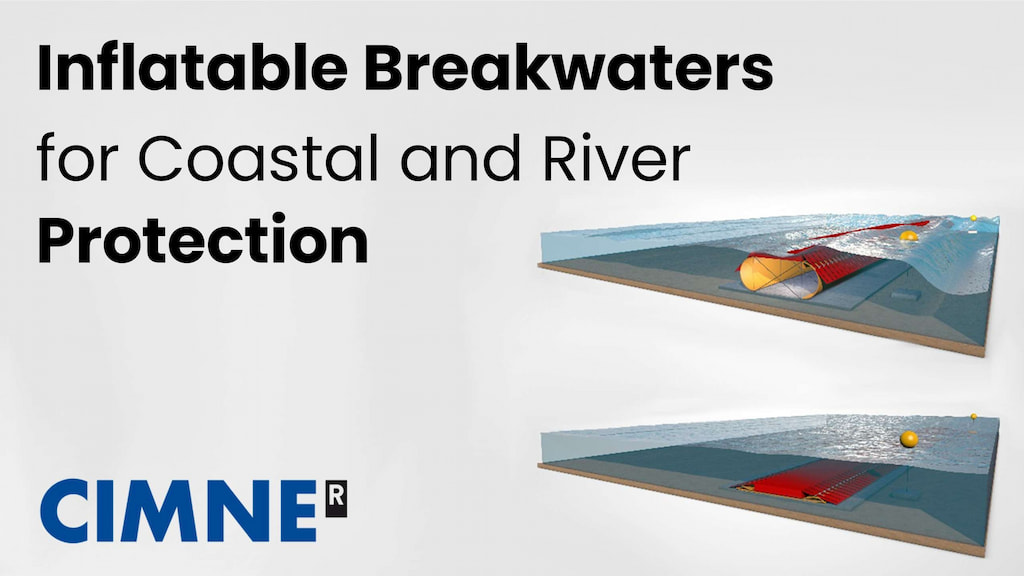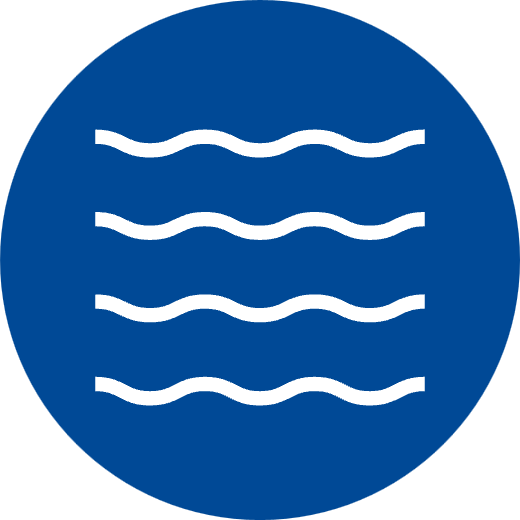
Overview
Inflatable breakwaters are flexible structures that deploy or retract according to flow conditions or environmental requirements. This innovative technology supports an integral management of the coastline to avoid the disappearance of the sand on the coast of the beaches, a growing environmental problem for the upcoming 30 years.
The technology is made up of a collection of polymer tubes anchored to the seafloor. Once the tubes are filled with water, they create a breakwater structure that emerges over the water surface and can mitigate the effect of incident waves. Unlike permanent structural breakwaters, CIMNE’s innovative solution can be used only during periods of rough weather to prevent the erosion of sandy beaches, minimising its environmental impact on natural sea currents and biodiversity when the water is calm.
The scale model of the inflatable breakwater was successfully tested at the 100m long wave channel of the Laboratory of Maritime Engineering (LIM) of the School of Civil Engineering at the Technical University of Catalonia (UPC) in 2021. The design and manufacturing of the model, as well as the experimental test, are part of the project “Validation of inflatable breakwaters design for the intelligent protection of sandy beaches against erosion”, funded by the European Regional Fund Programme (FEDER – Catalunya 2014-2020).
Sustainability and Ecological Restoration
Inflatable breakwaters offer an environmentally sustainable alternative to conventional coastal defence systems. These systems enable the modulation of water flow, reduce erosion processes, control sedimentation, and facilitate navigability without the need for permanent, rigid infrastructures. They are made of resistant materials, reversible installation, and can be remotely operated to dynamically adapt to extreme events or seasonal variations.
The principal advantage of the inflatable breakwater lies in its selective deployment: it can be inflated during storm conditions to protect the shoreline and deflated during calm periods to minimise its environmental footprint. This cyclical operation helps maintain natural sediment transport and preserves marine biodiversity.
This technology not only addresses local erosion and flooding issues but also promotes ecological balance. By adapting to the natural movements of the sea, inflatable breakwaters contribute to the regeneration of Posidonia flora, a vital seagrass species characteristic of the Mediterranean coast.
As a sustainable and efficient solution, inflatable breakwaters support integrated management of rivers, coasts, and estuaries, contributing to ecological restoration, climate change adaptation, and the long-term preservation of coastal environments.
In action
Simulation
This video shows a dynamic simulation of an inflatable breakwater system for coastal protection. The polymer tubes anchored to the seafloor inflate to form a wave-attenuating barrier during storm conditions, then deflate during periods of calm
Experimental test
This video shows how an inflatable breakwater has been successfully tested in a scale model at the 100m long wave channel in the Laboratory of Maritime Engineering (LIM) of the School of Civil Engineering at the Technical University of Catalonia (UPC) in 2021.
Features

Adaptive Deployment
Inflatable polymer structures that can be activated during storms and deflated in calm weather, adapting dynamically to sea conditions.

Rapid Activation
Quick inflation and deflation cycles allow fast response to extreme weather events or seasonal variations.

Resistant Materials
Made of durable polymers that ensure strength and longevity under marine conditions.

Scalable Design
Configurable in different sizes and arrays for use in coastal zones, estuaries, and river mouths.

Lightweight & Flexible
Ensures durability while maintaining easy transport and installation.

Remote Operation
Can be remotely operated to dynamically adapt to extreme events or seasonal variations.

Environmentally Reversible
Non-permanent and reversible installation minimizes long-term ecological impact on marine habitats and natural currents.

Proven Performance
Demonstrated effectiveness through testing at the 100 m wave channel of the LIM–UPC.
Applications and Social Benefits

Coastal Protection
Mitigates the impact of waves and prevents beach sand erosion.

Ecological Restoration
Contributes to the recovery of Posidonia flora, characteristic of the Mediterranean coast.

Climate Resilience
Provides an efficient tool for adapting to climate change.

Integrated Coastal Management
Supports the sustainable management of rivers, coasts, and estuaries.
Learn More
Project Milestones
Media Coverage
Contact Us
Interested in learning more about inflatable breakwaters or exploring how this technology can enhance coastal protection and erosion control?
Our Technology Transfer Unit is ready to discuss how this solution can be adapted to your specific needs and help and help safeguard your beaches, rivers, or estuaries while minimizing environmental impact.






